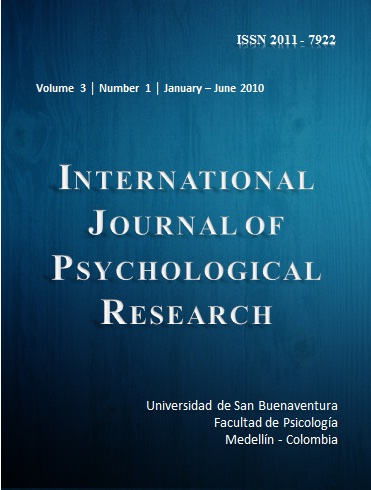How to Cite
Teknomo, K., & E. Estuar, M. R. (2010). Clustering as an EDA method: the case of pedestrian directional flow behavior. International Journal of Psychological Research, 3(1), 23–36. https://doi.org/10.21500/20112084.820
More Citation Formats
License terms
▼
The work that is sent to this journal must be original, not published or sent to be published elsewhere; and if it is accepted for publication, authors will agree to transfer copyright to International Journal of Psychological Research.
To give up copyright, the authors allow that, International Journal of Psychological Research, distribute the work more broadly, check for the reuse by others and take care of the necessary procedures for the registration and administration of copyright; at the same time, our editorial board represents the interests of the author and allows authors to re-use his work in various forms. In response to the above, authors transfer copyright to the journal, International Journal of Psychological Research. This transfer does not imply other rights which are not those of authorship (for example those that concern about patents). Likewise, preserves the authors rights to use the work integral or partially in lectures, books and courses, as well as make copies for educational purposes. Finally, the authors may use freely the tables and figures in its future work, wherever make explicit reference to the previous publication in International Journal of Psychological Research. The assignment of copyright includes both virtual rights and forms of the article to allow the editorial to disseminate the work in the manner which it deems appropriate.
The editorial board reserves the right of amendments deemed necessary in the application of the rules of publication.
To give up copyright, the authors allow that, International Journal of Psychological Research, distribute the work more broadly, check for the reuse by others and take care of the necessary procedures for the registration and administration of copyright; at the same time, our editorial board represents the interests of the author and allows authors to re-use his work in various forms. In response to the above, authors transfer copyright to the journal, International Journal of Psychological Research. This transfer does not imply other rights which are not those of authorship (for example those that concern about patents). Likewise, preserves the authors rights to use the work integral or partially in lectures, books and courses, as well as make copies for educational purposes. Finally, the authors may use freely the tables and figures in its future work, wherever make explicit reference to the previous publication in International Journal of Psychological Research. The assignment of copyright includes both virtual rights and forms of the article to allow the editorial to disseminate the work in the manner which it deems appropriate.
The editorial board reserves the right of amendments deemed necessary in the application of the rules of publication.
Abstract
Given the data of pedestrian trajectories in NTXY format, three clustering methods of K Means, Expectation Maximization (EM) and Affinity Propagation were utilized as Exploratory Data Analysis to find the pattern of pedestrian directional flow behavior. The analysis begins without a prior notion regarding the structure of the pattern and it consequentially infers the structure of directional flow pattern. Significant similarities in patterns for both individual and instantaneous walking angles based on EDA method are reported and explained in case studies.
References
Bierlaire, M., Antonini, G., & Weber, M. (2003). Behavioral dynamics for pedestrians. In K.
Axhausen, Moving through nets: The physical and social dimensions of travel. Elsevier.
Brillinger, D., Preisler, H., Haiganoush, K., Ager, A., & Kie, J. (2004). An exploratory data analysis (EDA) of the paths of moving animals. Journal of Statistical Planning and Inference 122 , 43-63.
Chebat, J., Gélinas-Chebat, C., & Therrien, K. (2005). Lost in a mall, the effects of gender, familiarity with the shopping mall and the shopping values on shoppers’ way finding processes. Journal of Business Research , 58 (11), 1590– 1598.
de Mast, J., & Trip, A. (2008). Exploratory data analysis in quality improvement projects. Journal of Quality Technology , 39 (4), 301-311.
Dempster, A., Laird, N., & Rubin, D. (1977). Maximum likelihood from incomplete data via the EM algorithm. Journal of the Royal Statistical Society, Series B , 39 (1), 1-38.
Axhausen, Moving through nets: The physical and social dimensions of travel. Elsevier.
Brillinger, D., Preisler, H., Haiganoush, K., Ager, A., & Kie, J. (2004). An exploratory data analysis (EDA) of the paths of moving animals. Journal of Statistical Planning and Inference 122 , 43-63.
Chebat, J., Gélinas-Chebat, C., & Therrien, K. (2005). Lost in a mall, the effects of gender, familiarity with the shopping mall and the shopping values on shoppers’ way finding processes. Journal of Business Research , 58 (11), 1590– 1598.
de Mast, J., & Trip, A. (2008). Exploratory data analysis in quality improvement projects. Journal of Quality Technology , 39 (4), 301-311.
Dempster, A., Laird, N., & Rubin, D. (1977). Maximum likelihood from incomplete data via the EM algorithm. Journal of the Royal Statistical Society, Series B , 39 (1), 1-38.
Downloads
Download data is not yet available.


































